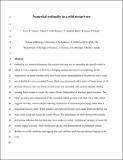Numerical ordinality in a wild nectarivore
Abstract
Ordinality is a numerical property that nectarivores may use to remember the specific order in which to visit a sequence of flowers, a foraging strategy also known as traplining. In this experiment, we tested whether wild, free-living rufous hummingbirds (Selasphorus rufus) could use ordinality to visit a rewarded flower. Birds were presented with a series of linear arrays of 10 artificial flowers; only one flower in each array was rewarded with sucrose solution. During training, birds learned to locate the correct flower independent of absolute spatial location. The birds' accuracy was independent of the rewarded ordinal position (1st, 2nd, 3rd or 4th), which suggests that they used an object-indexing mechanism of numerical processing, rather than a magnitude-based system. When distance cues between flowers were made irrelevant during test trials, birds could still locate the correct flower. The distribution of errors during both training and testing indicates that the birds may have used a so-called working up strategy to locate the correct ordinal position. These results provide the first demonstration of numerical ordinal abilities in a wild vertebrate and suggest that such abilities could be used during foraging in the wild.
Citation
Vámos , T I F , Tello-Ramos , M C , Hurly , T A & Healy , S D 2020 , ' Numerical ordinality in a wild nectarivore ' , Proceedings of the Royal Society B: Biological Sciences , vol. 287 , no. 1930 , 20201269 . https://doi.org/10.1098/rspb.2020.1269
Publication
Proceedings of the Royal Society B: Biological Sciences
Status
Peer reviewed
ISSN
0962-8452Type
Journal article
Description
This work was supported by the Association for the Study of Animal Behaviour (S.D.H.), the University of Lethbridge, and the Natural Sciences and Engineering Research Council of Canada (RGPIN 121496-2003; T.A.H.)Collections
Items in the St Andrews Research Repository are protected by copyright, with all rights reserved, unless otherwise indicated.

